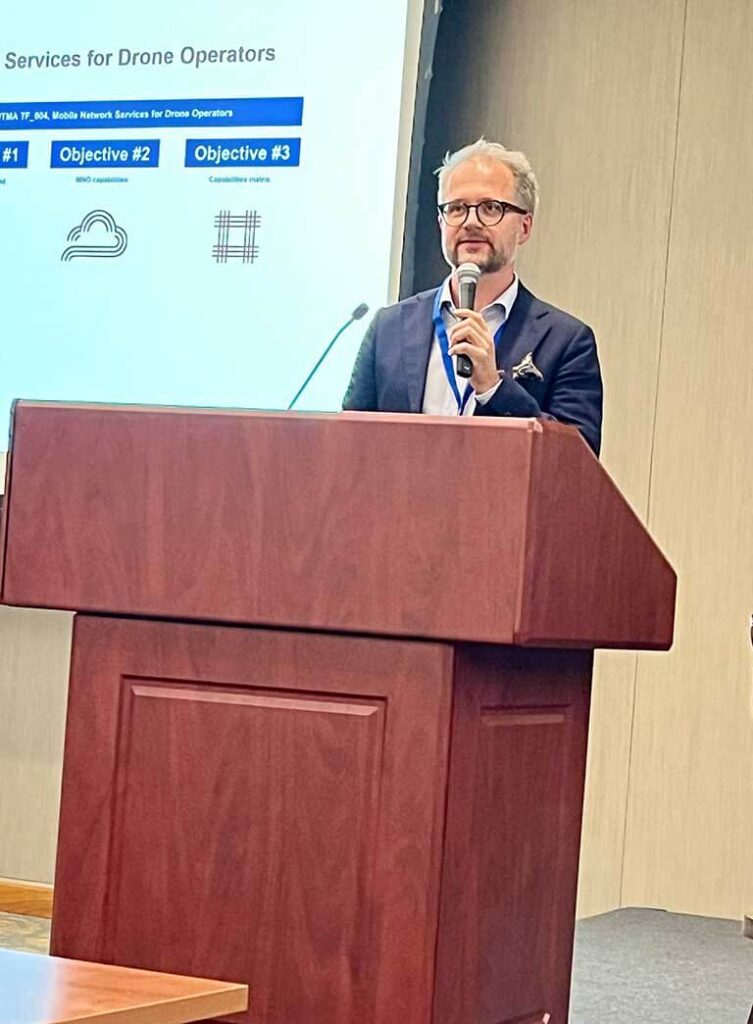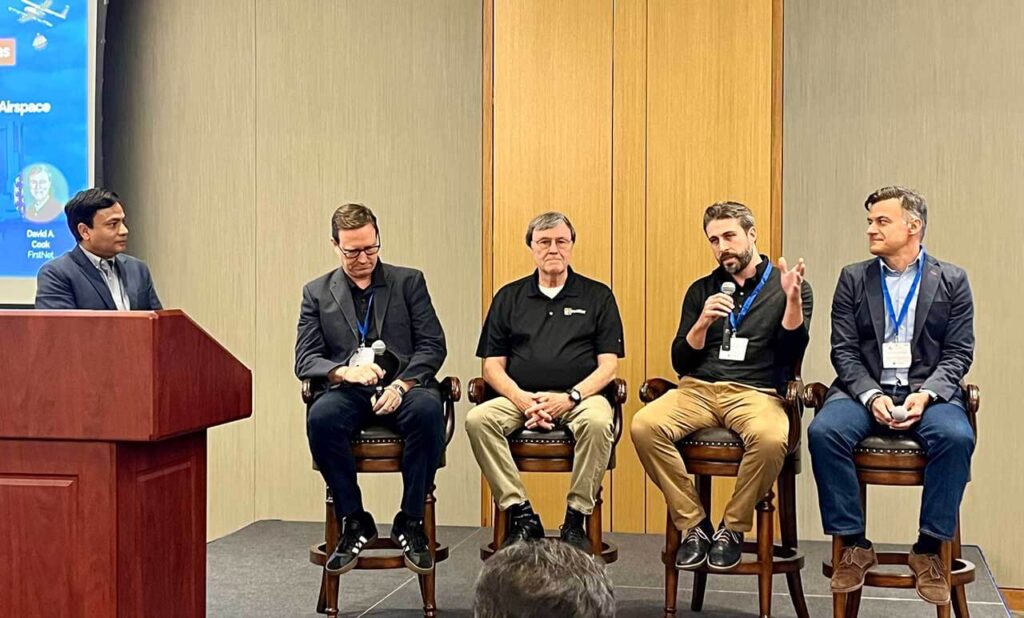The emergence of digital airspace—where drones and other uncrewed aerial systems (UAS) operate safely, efficiently and at scale—marks one of the most transformative shifts in aviation and public safety in decades. Mobile Network Operators (MNOs) provide the lifeblood of this effort. Their infrastructure, expertise and innovation enables the mission-critical connectivity and services that digital airspace demands. This article explores how MNOs have become indispensable partners for drone operators, regulators, and end-users, and why their evolving role is central to the future of digital airspace.

Connectivity: The Foundation of Digital Airspace
Reliable connectivity provides the foundation for digital airspace. For drones to operate beyond visual line of sight (BVLOS), stream high-definition video or deliver emergency payloads, robust, low-latency and secure communications remain essential. Today, MNOs provide this critical connectivity through their extensive LTE and 5G networks, enabling the real-time command and control (C2), data payload transmission and remote identification (Remote ID) vital for regulatory compliance and operational safety.
However, as Kapil Mittal, Global Head of Digital Airspace at Ericsson, noted, “Mobile networks were not originally designed for aerial users. Drones flying above cell towers experience different coverage patterns and interference challenges than ground-based devices, requiring network optimization and new design paradigms.”
Despite these challenges, MNOs have leveraged their technological assets to adapt their networks for aerial operations to provide reliable service for both urban and remote missions.
Beyond Connectivity: The Expanding Role of MNOs
While basic connectivity remains essential, MNOs have rapidly moved up the value chain to offer a suite of additional advanced services that address the evolving needs of the drone ecosystem.
Platform as a Service (PaaS) and End-to-End Solutions
MNOs continue to develop comprehensive platforms that integrate mission planning, network coverage analysis, real-time data processing and workflow management. Solutions like Vodafone’s DroNet HUB exemplify this shift. It allows operators to manage complex drone operations from planning to analysis with a single interface.
Swisscom’s Drone Network further demonstrates how MNOs can provide full-service solutions, including connectivity, risk management and regulatory approvals in real time to enable scalable BVLOS operations across multiple industries.
Airspace Surveillance and UTM Integration
MNOs seem uniquely positioned to support airspace surveillance and Uncrewed Traffic Management (UTM) systems by leveraging their cell tower infrastructure. By hosting specialized receivers and transmitting air traffic data via their networks, MNOs facilitate the coordination of low-altitude UAVs, enhance situational awareness and help authorities manage increasingly crowded skies. APIs and data interfaces developed by MNOs enable seamless integration with UTM platforms. This supports both cooperative and non-cooperative airspace management.
Data-Driven Risk Assessment and Population Density Insights
MNOs offer the invaluable ability to provide dynamic, hyper-localized data-such as real-time population density and mobility patterns-derived from their mobile networks. This information is crucial for risk assessment, regulatory compliance (e.g., avoiding flights over crowds) and optimizing flight paths for safety and efficiency. Importantly, they anonymize and aggregate these datasets to protect privacy, yet deliver a tionable intelligence to operators and regulators.
Hyper-Localized Weather and Environmental Data
By renting space on their infrastructure for weather stations and environmental sensors, MNOs can offer hyper-localized weather services as standalone or integrated solutions. Such data is invaluable for flight planning and in-flight adjustments, especially in rapidly changing or hazardous conditions.

Real-World Impacts: Public Safety, Emergency Response and Commercial Uses
The practical benefits of MNO-enabled digital airspace have already become evident across public safety, emergency response and commercial sectors.
Public Safety and Emergency Response
FirstNet, the dedicated public safety network built by AT&T in partnership with the First Responder Network Authority, exemplifies how MNOs are transforming emergency communications.
FirstNet’s “Flying COWs” (Cells on Wings)-tethered drones equipped with LTE/5G radios-provide rapid, resilient connectivity in disaster zones, wildfires or remote search-and-rescue missions where traditional infrastructure has been compromised or is nonexistent. These assets ensure first responders have unthrottled, prioritized access to mission-critical data and communications, even in the most challenging environments.
David Cook, Senior Public Safety Advisor for FirstNet, highlighted the unpredictable and dynamic nature of emergency response. “We never know where we’re going to be called to work. Drones give us immediate access to locations, whether it’s dropping life preservers to swimmers or surveying a wildfire. Our operations change quickly, and it’s vital that our connectivity is reliable, prioritized, and secure,” he said.
BRINC Drones, used by over 600 public safety agencies in the U.S., leverages real-time video streaming and secure communications over MNO networks to de-escalate dangerous situations, speed up 911 response and deliver life-saving payloads.
Walker Robb, VP of Engineering at BRINC, noted the critical need for real-time video and data streaming: “Our use case is providing real-time video streams to the end user. We’re also sending high-resolution thermal and visual data simultaneously. Knowing we have robust coverage and the ability to prioritize emergency communications is essential for effective response,” he explained.
With the rise of Drone as First Responder (DFR) programs and DFR 2.0 (with use of drones-in-a-box), MNOs’ ability to provide ultra-reliable, low-latency connectivity directly will continue to save lives and improve operational outcomes.
Cody Postier of FirstNet AT&T emphasized innovation in the public safety sector. “We’ve been very interested and excited about how we can use drone technology to create coverage solutions, especially in the aftermath of emergencies,” he noted. Postier continued, “The future will see even more high-powered use cases, with expanded coverage and capabilities enabled by 5G and beyond.”
Commercial and Industrial Applications
From infrastructure inspection to logistics and agriculture, commercial drone operators depend on MNOs for secure, high-bandwidth communications that support advanced applications like real-time video, AI-driven analytics and automated flight management. As regulatory frameworks evolve to enable more BVLOS operations, the demand for MNO-powered connectivity and services will only accelerate.

Security, Privacy, and Regulatory Compliance
Security and privacy remain paramount in digital airspace. MNOs bring decades of experience managing secure device registration (SIMs/eSIMs), end-to-end encryption and compliance with stringent data protection regulations.
For example, FirstNet’s secure messaging and video streaming solutions ensure that sensitive data transmitted from drones—such as live feeds from disaster scenes or law enforcement operations—remain protected from unauthorized access.
MNOs are also actively involved in developing and implementing standards for drone identification, airspace integration and interoperability, working closely with aviation authorities, regulators and industry partners to ensure that digital airspace remains safe, secure and efficient.
Scaling for the Future
Network Optimization and Coverage
As drones operate at higher altitudes and in more diverse environments, MNOs face unique challenges in optimizing coverage and minimizing interference. Urban canyons, rural dead zone and the vertical dimension of flight require innovative solutions, such as network slicing, dynamic beamforming and the deployment of aerial base stations. The transition to 5G, with its promise of ultra-reliable, low-latency communications and massive device density, will further enhance MNOs’ ability to support the growing scale and complexity of drone operations.
Investment and Business Models
The business case for MNO investment in digital airspace infrastructure continues to evolve. While public safety and government contracts (like FirstNet) justify investment in areas with low commercial return on investment, the burgeoning demand from commercial drone operators is creating new revenue streams for MNOs. As drone adoption scales—whether for delivery, inspection, or emergency response—MNOs will continue to invest in network enhancements, platform development and value-added services.
Collaboration and Ecosystem Development
The success of digital airspace depends on close collaboration between MNOs, drone manufacturers, regulators and end-users. Initiatives like the GSMA Drone Interest Group and global joint ventures among telecom operators foster the development of shared APIs, interoperability standards and best practices for safe and efficient airspace management.
MNOs as the Backbone of Digital Airspace
As digital airspace becomes an integral part of modern society—transforming public safety, logistics, infrastructure and more—MNOs have emerged as the backbone of this new ecosystem. Their ability to deliver robust, secure and scalable connectivity; provide advanced data and platform services; and collaborate across industries and regulatory domains positions them as essential enablers of the mission.
From real-time risk assessment to seamless UTM integration, from disaster response to commercial innovation, MNOs do not just provide the pipes—they are architecting the future of digital airspace. As the skies grow busier and the stakes higher, their role will only become more important in ensuring that the promise of digital airspace can be realized safely, efficiently and for the benefit of all.
This article is largely based on insights from two MNO panels at the GUTMA Harmonized Skies 2024 event consisting of industry leaders, public safety officials, and technology experts at the forefront of digital airspace innovation, including Ericsson, Verizon, AT&T FirstNet, BRINC and the GSMA Drone Interest Group.
Mark your calendars now to attend GUTMA’s Harmonized Skies 2025 in November in Zurich, Switzerland.
By: Dawn Zoldi

